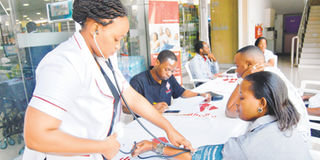High blood pressure a threat to young adults

Normal blood pressure is around 120/80 mmHg. PHOTO|FILE
What you need to know:
- Many of the young adults take a cavalier attitude to the problem of high blood pressure (BP). Having met and attended a host of young adults with high BP who at times seem to be taken aback by the readings, of late I have realised that it is imperative to write and talk about it.
- You too can have high BP, I can vouch for that unless you once tracked it.
One among the questions my patients often ask on record numbers is, “What is my blood pressure today? Next is, “Is it normal?”
Many of the young adults take a cavalier attitude to the problem of high blood pressure (BP). Having met and attended a host of young adults with high BP who at times seem to be taken aback by the readings, of late I have realised that it is imperative to write and talk about it.
You too can have high BP, I can vouch for that unless you once tracked it.
Understanding your blood pressure numbers
Normally when BP is checked, two values are recorded like this, 124/80. You can ask your doctor for you to see, since it is a routine practice to measure patients’ BP among other vital items before diagnosis.
Then, on BP measurements such as that, 124/80, this reading will be read as ‘one twenty four over eighty”, the upper number 124 occurs when the heart contracts (systole), and the lower one 80 occurs when the heart relaxes (diastole), thus BP is written as systolic pressure followed by a diastolic pressure.
Simply put, systole pressure is the force exerted by blood against arterial wall when the heart beats, whereas diastole is the pressure between the beats.
Now it is imperative to allude to the so called high BP (hypertension), which is defined as a systolic pressure that averages 140 mmHg or more and diastolic pressure that averages 90mmHg, more or less.
Normal BP ranges from 120/80 mmHg, while numbers that follow in between normal and high are regarded as ‘prehypertension’. This is likely to develop high BP (hypertension) unless preventive measures are adhered to.
Of course like the ocean tide, it is not abnormal for blood pressure to fall and to rise throughout a day.
It is said that BP is lowest when you are sleeping and rises when you are awaken, but when the pressure stays elevated over time it causes the heart to pump harder and work overtime possibly leading to serious health impacts, including damaging the brain and kidney.
It’s not just an old man’s problem
My last patient whom I attended last week was a 30-year-old man with his BP reading 142/85mmHg.
Upon briefing him on the findings, he asked, “Doctor I am just fine, young and energetic, yet you are telling me that my BP is high? How did that happen?”
My young patiend looked plumpy and huge for this age, and after alluding to important issues with regard to his questions I then added, “You better come back to have it measured again.”
May be he was not enthusiastic enough with the idea of checking it again, hence I haven’t seen him back again.
Unknown to many of our clients is the fact that hypertension is not an old man’s disease only, any one can face it. Hypertension is a silent killer, ignoring its presence is dicing with death.
It is said that the causes of primary hypertension are unknown although lifestyle factors such as obesity , sedentary lifestyle and excessive alcohol or salt intake can contribute to the condition
In secondary hypertension, the causes must be known which may be, kidney diseases, hormonal imbalance or drugs including alcohol and cocaine, but it is my understanding that you might be willing to know what do these terms mean.
Secondary hypertension can have an underlying, potentially preventable causes whereas primary/essential hypertension is high BP that does not have a known secondary cause.
Advise on tackling the challenges
The question that I always seek to address whenever I meet young adults with elevated BP at outpatient department is what causes hypertension in them.
Posing a daunting challenge in Tanzania is where by a patient with a potentially identifiable and correctable secondary cause ends up inconsistently swallowing BP lowering pills.
A lot of the young adults in pre-hypertension stage do not take the matter seriously.
Researchers including the Bakris’ and Allen’s teams have found that, young people with elevated BP might have other issues too, they further assert that if elevated BP is left unchecked, it can start taking a toll on their arteries early in life.
If you wait till you are 40s or 50s to address it, the damage to the artery may be already done.
A couple of months ago I received the sad news of the untimely death of one my classmates who was initially diagnosed with secondary hypertension who died of kidney complications.
It is disheartening to hear that she could not cope with the daily swallowing of pills and visiting the hospital for further possible checkups or investigations till when she succumbed to death.
Of course it is said that there are higher rates of deaths from stroke and kidney diseases in hypertensive patients.
As the saying goes, “an ounce of prevention is worth a pound of cure”, in all cases, patients are advised to lose excess weight, exercise consistently, not to smoke and to limit intake of alcohol beverages.
Dr Stein Richard at Newyork University centre for prevention of cardiovascular diseases says, “Even if your problem of pre- hypertension is not that high, its still tough on your body, it is causing your heart muscles to beat against a high BP, so the heart is becoming thicker”
Don’t take your BP readings for granted, cultivate a health seeking behaviour, doctors are there to help you.
The author is a medical doctor, researcher and a public health activist




